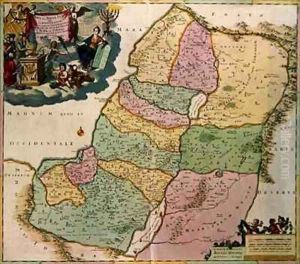Theodorus Danckerts Paintings
Theodorus Danckerts, born in 1663, was a notable Dutch cartographer and engraver from the 17th and early 18th centuries. His work came at a time when the Dutch Republic was at the height of its Golden Age, a period marked by significant achievements in art, science, and commerce. Danckerts was part of a renowned family of cartographers and engravers that significantly contributed to the Dutch tradition of mapmaking, which was pivotal in the exploration and understanding of the world during that era.
Danckerts' contributions to cartography were part of a broader Dutch endeavor to chart the globe meticulously. His works included detailed maps of various parts of the world, contributing valuable knowledge to the fields of geography and navigation. These maps were not only functional but also highly decorative, featuring artistic embellishments that were typical of the time. They often included elaborate borders, maritime scenes, and allegorical figures, making them prized possessions among collectors and scholars of the period.
Throughout his career, Theodorus Danckerts published numerous atlases and individual maps. His work was instrumental in disseminating the latest geographical knowledge and was widely sought after in Europe and beyond. Despite facing competition from other cartographers and the challenge of accessing reliable geographic information, Danckerts' maps reflected the high standards of accuracy and craftsmanship that were trademarks of Dutch mapmaking.
After his death in 1727, Theodorus Danckerts' legacy continued through the works he left behind. His maps provide historians and scholars with insights into the geographical understanding of his time and the aesthetic qualities of Dutch cartographic art. Danckerts is remembered as a significant figure in the history of mapmaking, embodying the spirit of exploration and the pursuit of knowledge that defined the Dutch Golden Age.
